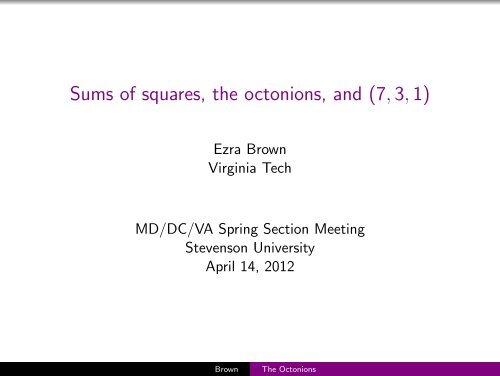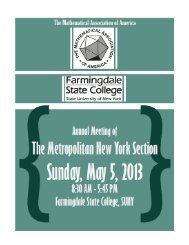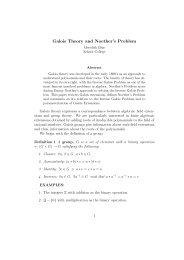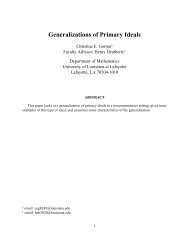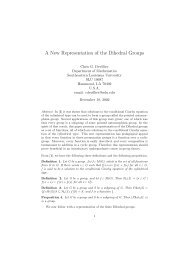Sums of squares, the octonions, and (7,3,1) - MAA Sections
Sums of squares, the octonions, and (7,3,1) - MAA Sections
Sums of squares, the octonions, and (7,3,1) - MAA Sections
Create successful ePaper yourself
Turn your PDF publications into a flip-book with our unique Google optimized e-Paper software.
<strong>Sums</strong> <strong>of</strong> <strong>squares</strong>, <strong>the</strong> <strong>octonions</strong>, <strong>and</strong> (7, 3, 1)<br />
Ezra Brown<br />
Virginia Tech<br />
MD/DC/VA Spring Section Meeting<br />
Stevenson University<br />
April 14, 2012<br />
Brown<br />
The Octonions
What To Expect<br />
<strong>Sums</strong> <strong>of</strong> <strong>squares</strong><br />
Normed algebras<br />
(7, 3, 1)<br />
1-, 2- <strong>and</strong> 4-square identities <strong>and</strong> <strong>the</strong>ir algebras<br />
8 <strong>squares</strong><br />
The <strong>octonions</strong><br />
The connection with (7, 3, 1)<br />
Brown<br />
The Octonions
A question about sums <strong>of</strong> <strong>squares</strong><br />
<strong>Sums</strong> <strong>of</strong> <strong>squares</strong><br />
For which n can <strong>the</strong> product <strong>of</strong> two sums <strong>of</strong> n <strong>squares</strong> always be<br />
written as a sum <strong>of</strong> n <strong>squares</strong>?<br />
Answer (A. Hurwitz, 1898): For n = 1, 2, 4 <strong>and</strong> 8 — <strong>and</strong> for no o<strong>the</strong>r<br />
positive integers.<br />
Theorem: Each sums-<strong>of</strong>-<strong>squares</strong> identity is associated with a normed<br />
algebra over <strong>the</strong> real numbers.<br />
Brown<br />
The Octonions
Normed algebras<br />
A real algebra is a vector space over R that has a vector<br />
multiplication that distributes over vector addition.<br />
A normed algebra is a real algebra A equipped with a mapping<br />
N : A → R such that N(uv) = N(u)N(v) for all u, v ∈ A.<br />
The real numbers R <strong>and</strong> <strong>the</strong> complex numbers C both have such<br />
norms.<br />
We’ll meet <strong>the</strong> o<strong>the</strong>r two shortly.<br />
Brown<br />
The Octonions
The (7, 3, 1) block design<br />
The (7, 3, 1) block design is:<br />
B 1 124<br />
B 2 235<br />
B 3 346<br />
B 4 457<br />
B 5 561<br />
B 6 672<br />
B 7 713<br />
a set V <strong>of</strong> 7 items, <strong>and</strong> a collection <strong>of</strong> 7 subsets <strong>of</strong> V called blocks,<br />
such that<br />
each block contains three items,<br />
each item is in three blocks, <strong>and</strong><br />
each pair <strong>of</strong> items is in exactly one block toge<strong>the</strong>r.<br />
Brown<br />
The Octonions
The incidence matrix for (7, 3, 1)<br />
The incidence matrix for (7, 3, 1) is <strong>the</strong> 7 × 7 (0, 1) matrix M with<br />
M ij = 1 if <strong>and</strong> only if B i contains <strong>the</strong> jth object:<br />
1 2 3 4 5 6 7<br />
B 1 1 1 0 1 0 0 0 124<br />
B 2 0 1 1 0 1 0 0 235<br />
B 3 0 0 1 1 0 1 0 346<br />
B 4 0 0 0 1 1 0 1 457<br />
B 5 1 0 0 0 1 1 0 561<br />
B 6 0 1 0 0 0 1 1 672<br />
B 7 1 0 1 0 0 0 1 713<br />
Remember this, because it’s important.<br />
Brown<br />
The Octonions
One <strong>and</strong> two <strong>squares</strong><br />
One square<br />
The identity: a 2 · b 2 = (ab) 2<br />
The algebra: R, <strong>the</strong> real numbers<br />
The norm: N(r) = r 2 .<br />
Two <strong>squares</strong><br />
The identity: (a 2 + b 2 )(c 2 + d 2 ) = (ac − bd) 2 + (ad + bc) 2 , due to<br />
Diophantus (3rd century) <strong>and</strong> Brahmagupta (7th century)<br />
The algebra: C = {a + bi|a, b ∈ R, i 2 = −1}, <strong>the</strong> complex numbers<br />
The norm: N(a + bi) = a 2 + b 2<br />
The origins <strong>of</strong> C: solution <strong>of</strong> <strong>the</strong> cubic, differential equations, <strong>the</strong><br />
geometric complex plane<br />
Brown<br />
The Octonions
Four <strong>squares</strong><br />
The identity, due to Euler (1748):<br />
(a 2 1 + a 2 2 + a 2 3 + a 2 4)(b 2 1 + b 2 2 + b 2 3 + b 2 4) =<br />
= (a 1 b 1 − a 2 b 2 − a 3 b 3 − a 4 b 4 ) 2 + (a 1 b 2 + a 2 b 1 + a 3 b 4 − a 4 b 3 ) 2<br />
+(a 1 b 3 − a 2 b 4 + a 3 b 1 + a 4 b 2 ) 2 + (a 1 b 4 + a 2 b 3 − a 3 b 2 + a 4 b 1 ) 2<br />
The algebra: <strong>the</strong> quaternions<br />
H = {a 1 + a 2 i + a 3 j + a 4 k|a 1 , a 2 , a 3 , a 4 ∈ R, i 2 = j 2 = k 2 = ijk = −1}<br />
The norm: N(a 1 + a 2 i + a 3 j + a 4 k) = a 2 1 + a2 2 + a2 3 + a2 4<br />
The origins: W. R. Hamilton, who —<br />
failed in an attempt to define a multiplication on R 3 , <strong>and</strong> <strong>the</strong>n —<br />
succeeded in defining a noncommutative multiplication on R 4 .<br />
Brown<br />
The Octonions
Eight <strong>squares</strong><br />
(a1 2 + a2 2 + a2 3 + a2 4 + a2 5 + a2 6 + a2 7 + a2 8 )<br />
×(b1 2 + b2 2 + b2 3 + b2 4 + b2 5 + b2 6 + b2 7 + b2 8 )<br />
= (a 1 b 1 − a 2 b 2 − a 3 b 3 − a 4 b 4 − a 5 b 5 − a 6 b 6 − a 7 b 7 − a 8 b 8 ) 2<br />
+(a 1 b 2 + a 2 b 1 + a 3 b 4 − a 4 b 3 + a 5 b 6 − a 6 b 5 − a 7 b 8 + a 8 b 7 ) 2<br />
+(a 1 b 3 − a 2 b 4 + a 3 b 1 + a 4 b 2 + a 5 b 7 + a 6 b 8 − a 7 b 5 − a 8 b 6 ) 2<br />
+(a 1 b 4 + a 2 b 3 − a 3 b 2 + a 4 b 1 + a 5 b 8 − a 6 b 7 + a 7 b 6 − a 8 b 5 ) 2<br />
+(a 1 b 5 − a 2 b 6 − a 3 b 7 − a 4 b 8 + a 5 b 1 + a 6 b 2 + a 7 b 3 + a 8 b 4 ) 2<br />
+(a 1 b 6 + a 2 b 5 − a 3 b 8 + a 4 b 7 − a 5 b 2 + a 6 b 1 − a 7 b 4 + a 8 b 3 ) 2<br />
+(a 1 b 7 + a 2 b 8 + a 3 b 5 − a 4 b 6 − a 5 b 3 + a 6 b 4 + a 7 b 1 − a 8 b 2 ) 2<br />
+(a 1 b 8 − a 2 b 7 − a 3 b 6 + a 4 b 5 − a 5 b 4 − a 6 b 3 + a 7 b 2 + a 8 b 1 ) 2<br />
Due to F. Degen (1818), J. T. Graves (1843) <strong>and</strong> A. Cayley (1845)<br />
Brown<br />
The Octonions
Eight <strong>squares</strong>, continued<br />
The algebra: <strong>the</strong> <strong>octonions</strong> O, where<br />
O = {a 0 + a 1 e 1 + . . . + a 7 e 7 |a 0 , . . . , a 7 ∈ R, e 2 t = −1}; <strong>the</strong> e t are<br />
called <strong>the</strong> octonion units<br />
The norm:<br />
N(a 0 + a 1 e 1 + · · · + a 7 e 7 ) = a 2 1 + a2 1 + a2 2 + a2 3 + a2 4 + a2 5 + a2 6 + a2 7<br />
The origins: J. T. Graves, who —<br />
received Hamilton’s letter announcing <strong>the</strong> quaternions, <strong>and</strong> <strong>the</strong>n —<br />
went him one better by defining a noncommutative <strong>and</strong> nonassociative<br />
multiplication on R 8 .<br />
The multiplication is given by <strong>the</strong> following table.<br />
Brown<br />
The Octonions
Multiplying <strong>the</strong> octonion units<br />
∗ 1 e 1 e 2 e 3 e 4 e 5 e 6 e 7<br />
1 1 e 1 e 2 e 3 e 4 e 5 e 6 e 7<br />
e 1 e 1 −1 e 4 e 7 −e 2 e 6 −e 5 −e 3<br />
e 2 e 2 −e 4 −1 e 5 e 1 −e 3 e 7 −e 6<br />
e 3 e 3 −e 7 −e 5 −1 e 6 e 2 −e 4 e 1<br />
e 4 e 4 e 2 −e 1 −e 6 −1 e 7 e 3 −e 5<br />
e 5 e 5 −e 6 e 3 −e 2 −e 7 −1 e 1 e 4<br />
e 6 e 6 e 5 −e 7 e 4 −e 3 −e 1 −1 e 2<br />
e 7 e 7 e 3 e 6 −e 1 e 5 −e 4 −e 2 −1<br />
This looks very strange . . .<br />
Multiplication table for <strong>the</strong> octonion units.<br />
Brown<br />
The Octonions
The table as a matrix <strong>of</strong> signs <strong>of</strong> <strong>the</strong> e i<br />
. . . but looks are deceptive.<br />
⎡<br />
H =<br />
⎢<br />
⎣<br />
1 1 1 1 1 1 1 1<br />
1 −1 1 1 −1 1 −1 −1<br />
1 −1 −1 1 1 −1 1 −1<br />
1 −1 −1 −1 1 1 −1 1<br />
1 1 −1 −1 −1 1 1 −1<br />
1 −1 1 −1 −1 −1 1 1<br />
1 1 −1 1 −1 −1 −1 1<br />
1 1 1 −1 1 −1 −1 −1<br />
⎤<br />
⎥<br />
⎦<br />
Brown<br />
The Octonions
The matrix, altered slightly . . .<br />
Remove <strong>the</strong> top row <strong>and</strong> left column, replace each −1 by a zero, <strong>and</strong><br />
move <strong>the</strong> bottom row to <strong>the</strong> top. Here’s <strong>the</strong> result:<br />
⎡<br />
⎤<br />
1 1 0 1 0 0 0<br />
0 1 1 0 1 0 0<br />
0 0 1 1 0 1 0<br />
0 0 0 1 1 0 1<br />
⎢ 1 0 0 0 1 1 0<br />
⎥<br />
⎣ 0 1 0 0 0 1 1 ⎦<br />
1 0 1 0 0 0 1<br />
Brown<br />
The Octonions
. . . becomes <strong>the</strong> incidence matrix for (7, 3, 1)<br />
1 2 3 4 5 6 7<br />
B 1 1 1 0 1 0 0 0 124<br />
B 2 0 1 1 0 1 0 0 235<br />
B 3 0 0 1 1 0 1 0 346<br />
B 4 0 0 0 1 1 0 1 457<br />
B 5 1 0 0 0 1 1 0 561<br />
B 6 0 1 0 0 0 1 1 672<br />
B 7 1 0 1 0 0 0 1 713<br />
I told you it was important.<br />
Brown<br />
The Octonions
Octonion multiplication, explained<br />
The following are <strong>the</strong> seven blocks <strong>of</strong> <strong>the</strong> (7, 3, 1) design, with <strong>the</strong><br />
given internal orderings: (1, 2, 4), (2, 3, 5), (3, 4, 6), (4, 5, 7), (5, 6, 1),<br />
(6, 7, 2), <strong>and</strong> (7, 1, 3).<br />
For distinct i, j ∈ {1, 2, 3, 4, 5, 6, 7}, define e i e j = e k = −e j e i , where<br />
(i, j, k) is <strong>the</strong> unique block containing i <strong>and</strong> j, in <strong>the</strong> given internal<br />
ordering.<br />
What is e 4 e 6 ? The relevant block is (3, 4, 6), so e 4 e 6 = e 3 .<br />
What is e 5 e 1 ? The relevant block is (5, 6, 1), so e 5 e 1 = −e 1 e 5 = −e 6 .<br />
That’s why “<strong>the</strong> octonion units” is a name for (7, 3, 1).<br />
But wait — <strong>the</strong>re’s ano<strong>the</strong>r reason.<br />
Brown<br />
The Octonions
O is ano<strong>the</strong>r name for (7, 3, 1)<br />
Seven quaternion subalgebras <strong>of</strong> O<br />
O contains seven complex subalgebras C n = R〈e n 〉 <strong>and</strong> seven<br />
quaternion subalgebras H n = R〈e t , e u , e v 〉, where {t, u, v} is a block<br />
in (7, 3, 1)<br />
Each H n contains three <strong>of</strong> <strong>the</strong> C k .<br />
Each C k is contained in three <strong>of</strong> <strong>the</strong> H n .<br />
Each pair {C k , C m } is contained in a unique H n toge<strong>the</strong>r.<br />
The (7, 3, 1) design sits inside O<br />
The above design <strong>of</strong> subalgebras <strong>of</strong> O has <strong>the</strong> same incidence matrix<br />
as (7, 3, 1).<br />
The two designs are <strong>the</strong> same!<br />
Brown<br />
The Octonions
THANK YOU!<br />
Brown<br />
The Octonions


